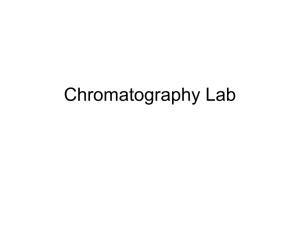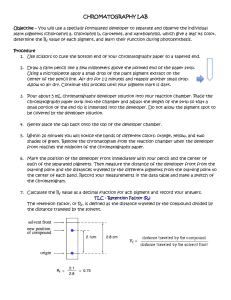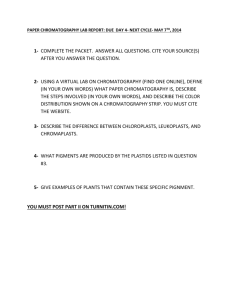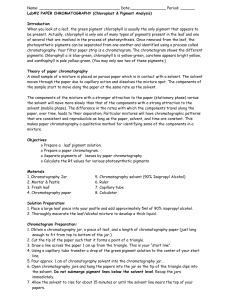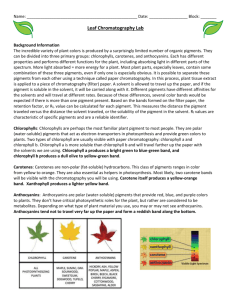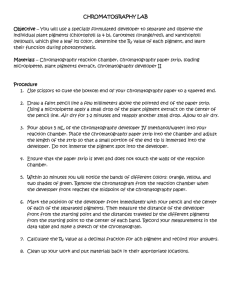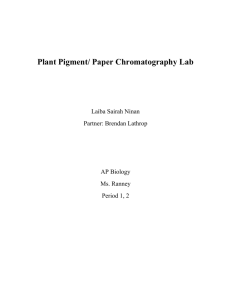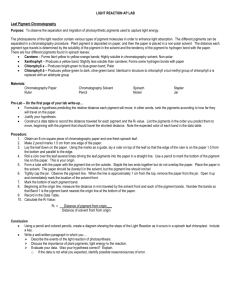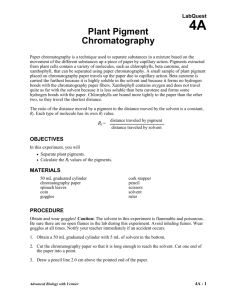Plant Pigment Chromatography
advertisement
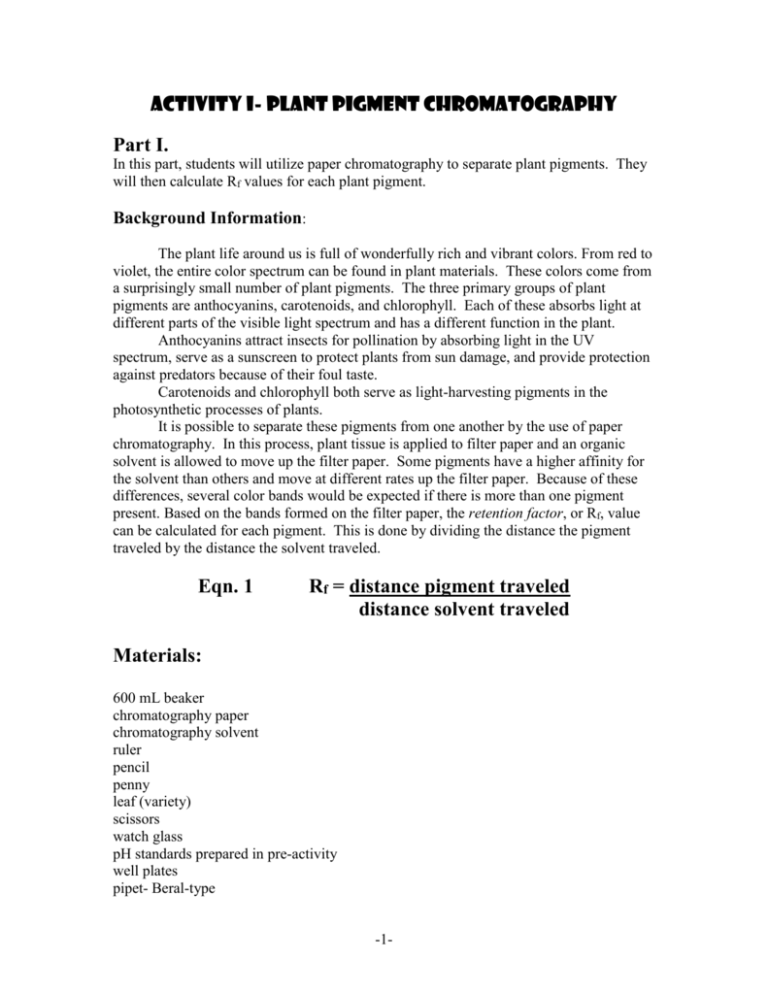
Activity I- Plant Pigment Chromatography Part I. In this part, students will utilize paper chromatography to separate plant pigments. They will then calculate Rf values for each plant pigment. Background Information: The plant life around us is full of wonderfully rich and vibrant colors. From red to violet, the entire color spectrum can be found in plant materials. These colors come from a surprisingly small number of plant pigments. The three primary groups of plant pigments are anthocyanins, carotenoids, and chlorophyll. Each of these absorbs light at different parts of the visible light spectrum and has a different function in the plant. Anthocyanins attract insects for pollination by absorbing light in the UV spectrum, serve as a sunscreen to protect plants from sun damage, and provide protection against predators because of their foul taste. Carotenoids and chlorophyll both serve as light-harvesting pigments in the photosynthetic processes of plants. It is possible to separate these pigments from one another by the use of paper chromatography. In this process, plant tissue is applied to filter paper and an organic solvent is allowed to move up the filter paper. Some pigments have a higher affinity for the solvent than others and move at different rates up the filter paper. Because of these differences, several color bands would be expected if there is more than one pigment present. Based on the bands formed on the filter paper, the retention factor, or Rf, value can be calculated for each pigment. This is done by dividing the distance the pigment traveled by the distance the solvent traveled. Eqn. 1 Rf = distance pigment traveled distance solvent traveled Materials: 600 mL beaker chromatography paper chromatography solvent ruler pencil penny leaf (variety) scissors watch glass pH standards prepared in pre-activity well plates pipet- Beral-type -1- Procedure: 1. Obtain all materials and bring them to your lab station. 2. Cut chromatography paper in half lengthwise. 3. Cut one end of the chromatography paper into a point or tip. Make a light pencil line about 1.0 cm from the end of the paper you just cut. 4. Use the coin to extract plant pigments from the leaf. Take the leaf and place it over the pencil line you have drawn. Roll the penny over the leaf at the same position as the pencil line. You should see plant pigment across the pencil line you have drawn. Move the leaf around and repeat this step 8-10 times using different parts of the leaf. 5. Pour about 1.0 cm of solvent into the bottom of the 600 mL beaker. Place the tip of the filter paper in the solvent being careful not to let the solvent touch the plant pigment line you have made. 6. Place a watch glass over the 600 mL beaker. The solvent should travel up the filter paper. 7. When the solvent is about 1-2 cm from the top of the filter paper remove the filter paper and make a pencil mark where the solvent stopped before the solvent evaporated. 8. Allow the paper to dry. Once the paper dries, draw a pencil line at the bottom of each distinguishable pigment band on the filter paper. Depending on the leaf you used, you should see 4-5 bands. 9. Repeat the procedure one more time with a different leaf or petal. Example of filter paper for a green leaf (Milanareaschools.org) -2- Student Data and Calculations: After the filter paper has dried, you are ready to begin calculating Rf values using Equation. 1. Using your ruler, fill in the following tables and calculate Rf values for one of your pieces of filter paper. Band Distances Band Distance (mm) Band Color 1 2 3 4 5 Distance solvent moved in mm _________________________ Rf values for pigments Pigment Carotene (yellow orange) Rf Xanthophylls (yellow) Chlorophyll A (bright green) Chlorophyll B (olive or yellow green) Anthocyanin (red) -3- Questions and Applications: 1. Did you find all five pigments in your plant sample? If not, suggest a reason why the pigment may have been missing. 2. Compare your Rf values to the group next to you. Are your values close? Calculate the percent difference between the two Rf values for each pigment. 3. The accepted Rf values for each pigment in this solvent are as follows: carotene - 0.98 chlorophyll a - 0.59 chlorophyll b - 0.42 xanthophylls – 0.67 Calculate the percent error using these values as the accepted value and your values as the experimental value. 4. Why do you think some pigments moved farther than others? 5. Why is it important for plants to have more than one pigment? -4- Part II. In this part of the activity, you will take the pigments you have separated by paper chromatography and attempt to use them as acid/base indicators. Background Information: An acid/base indicator (such as litmus) is a substance that is either a weak acid or a weak base that gives scientists a means of identifying solutions as acidic or basic utilizing a color change. The conjugate acid or conjugate base of an indicator is a different color than the acid or base itself and thus a color change occurs (litmus is blue in a basic environment and red in an acidic environment). The following generic reaction illustrates this concept: HIn Acid (Red) H+ + InConjugate base (blue) Utilizing Le Chatelier’s principle we can understand this concept further. When an acid is added to this environment, the concentration of H+ ions increases which shifts the equilibrium to the left (the red side). When a base is added to this environment, the concentration of H+ ions goes down which shifts the equilibrium to the right (the blue side). Procedure: 1. Cut out each separate pigment from the chromatography strips you made in part I. Do this for both of the chromatography strips. 2. Place approximately 2 ml of every pH solution you prepared in the preliminary activity in a well plate. 3. Dip each chromatography strip you just cut out into each of the well plates. Use one sample of pigments for the acidic portion of your well plates (pH 1-7) and use the other for the basic portion (pH 8-13). (For example: dip the chlorophyll a strip you cut out from one piece of chromatography paper into the wells containing solutions 1-7 and then take the other chlorophyll a strip and dip it into the wells containing solutions 8-13) 4. Note any color changes that take place in the student data section that follows. -5- Student Data: Create a data table that will allow you to record the color changes you saw for each different plant pigment across the pH range. Questions and Applications: 1. Which plant pigments would you consider to be acid/base indicators? 2. What color changes did you observe for the plant pigments that were acid/base indicators? 3. Suggest a simple equilibrium system (similar to the one in the background info) that would describe these pigments as acid/base indicators. -6- References: Senese, Fred. "Water to Wine." General Chemistry Online. 31 July 2007. Frostburg. 19 June 2008 <http://antoine.frostburg.edu/chem/senese /101/features/water2wine .shtml>. Reiss, Carol. Experiments in Plant Physiology. Englewood Cliffs, NJ: Prentice Hall, 1994. "Plant Pigment Chromotography." Milanareaschools.Org. 19 June 2008 <http://milanareaschools.org/~wbenya/Biology/documents/chromatography%20la b.pdf>. -7- Teachers Notes and Suggestions: 1. The chromatography solvent suggested is approximately a 9:1 mixture of petroleum ether and acetone. Other chromatography solvents can be found online. You may want to experiment with other solvents to see what works best for you and your students. 2. The Rf values used in this laboratory as accepted values are formed with a 3:1:1 petroleum ether/acetone/chloroform solvent. Therefore, the Rf values your students get will be slightly different. Student values should be on the same order of these values since both are nonpolar organic solvents. It is a good exercise in percent error since error is expected with the different solvents. 3. Any leaf specimens can be used for this laboratory. It is suggested that you use leaves that have vibrant red coloring so they will yield anthocyanins. This pigment is needed because it will be the acid/base indicator that is used in the subsequent activities. We have used 4. Make sure students save the solutions made in the pre-activity for the second exploration in this series. Suggested Resources and Further Reading: Kalb, Dee A., and G. W. Howard. "Analysis of Plant Pigments Using Paper Chromatography and Visible and/or UV Spectroscopy." Purdue University Instrument Van Project. Purdue University. 19 June 2008 <http://www.chem.purdue.edu/teacher/table_of_contents/UVVUS/UVVIS.Plant %20Pigments_CH.pdf>. This website provides a further application of plant pigments with spectroscopy. If you are interested in extending this lab, this is an invaluable resource. Marsden, Steve. "Separation of Plant Pigments by Paper Chromatography." Chemtopics.Com. 19 Aug. 2007. 19 June 2008 <http://www.chemtopics.com/unit06/pchrom.pdf>. This website provides some more information discussing why the process of paper chromatography is used to separate plant pigments. "Red Cabbage Acid Base Indicator." 27 Feb. 2002. University of Minnesota. 19 June 2008 <http://www.chem.umn.edu/services/lecturedemo/info/Cabbage_Indicator .html>. This website provides more information on why anthocyanins are acid/base indicators. -8-
